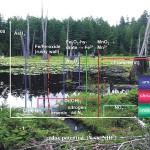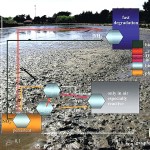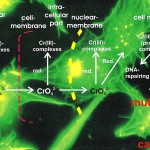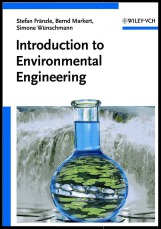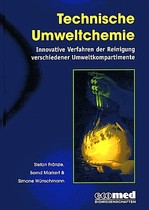Environmental Engineering
Introduction to Environmental Engineering
Fränzle S, Markert B, Wünschmann S (2012)Wiley-VCH, Weinheim
A really big challenge – because of requiring to somewhat predict the future – is prophylactic work against forthcoming environmental damages. Here, environmentally benign methods of production are chosen to anticipate and avoid actual environmental damages. For this aim, one must estimate the possible results and by-effects of different alternative or competing technologies to both the environment and to translating political ends – better sustainability, avoidance of public hazards, omitting some techniques or chemicals – into practical technical know-how and application in advance.
Obviously, some of these topics are quite complex to grasp. Hence we opted rather to “narrate” things, developments and options touching issues of environmental diagnostics, therapy and prophylaxes in their respective historical context, to make you understand why people did select one technology e.g. for vehicle propulsion or another, thereby accepting environmental risks. Notwithstanding this, interested readers are fully supplied with definitions of terms and causes, formulas and tasks of comprehensive environmental technologies as they are in the third millennium so much shaped by information and communication technologies. But this is not a technocratic perspective: we also address ethical issues and juridical, political implications on national and global scales when musing what could be done to achieve a more sustainable, “greener” yet responsible and libertarian way of life.
Fränzle-Markert-Wünschmann 2012.pdf
PDF-Dokument [428.7 KB]
Starting with comparisons from general systems sciences as well as comparative planetology, features of the three environmental compartments atmosphere, water (distinguishing fresh-, sea- and groundwaters), and soil/sediment (regolith, respectively) are analyzed in terms of a chemical reactor concept (what happens why where?), pointing out chances and limitations put thereby to environmental sanitation. Specific chemical and biophysical properties of single environmental compartments thus logically define the levers to be used by innovative cleaning and protection methods devised and corroborated by engineering- and natural sciences.
We finally hope you to enjoy reading this introductory textbook and get some information and the stimulus and encouragement in practically applying one or another of these possibilities we lined out.
Content of the book
INTRODUCTION
Definition of environmental engineering
History and development of environmental engineering
From environmental chemistry and technology to environmental engineering: Understanding and diversify anthropogenic environmental influences
How to determine environmental pollution
The Biological System of the Elements (BSE)
Information and communication
Ethical aspects
THE COMPARTMENTS OF THE ENVIRONMENT
The three environmental compartments and their mutual interactions: lessons for environmental situation analysis and technologies to be learned from comparative planetology
Properties of Earth's environmental compartments and options to clean them depending on it
A comparison among environmental compartments: phase composition, miscibility towards key reactants and contaminants, transparency and biological activity
INNOVATIVE TECHNOLOGIES
Criteria for innovation
Examples of innovative environmental technologies
CASE STUDIES
Atmosphere: Biondication and biomonitoring are innovative means for monitoring and controlling environmental situations: the case of atmospheric emission surveillance
Atmosphere: CO2-reduction
Soils and sediments: Phytoremediation by use of organisms
Soils and sediments: Ethylenediamine tetraacetic acid (EDTA) - its chemical properties, persistence, ecological hazards and methods of removal
Water: Reactive walls
Water: Pharmaceuticals in the environment - special emphasis to Diclofenac (Voltaren) – an analgetic agent with difficult and interesting properties
Energy: The need for Renewable Energy
Appendix
Literature
Glossary
Index
German textbook on "Technical Environmental Chemistry" written by Fränzle S, Markert B and Wünschmann S (2005). In 2007 published by www.wiley-vch.de
Summary of the publisher:
Einführung und Lehrbuch zur Technischen Umweltchemie
Das vorliegende Buch will den Leser zu einem vertieften Verständnis von Grundlagen und Anwendungen des transdisziplinären Wissens-gebiets Technische Umweltchemie führen, indem es den Weg vom chemischen Phänomen oder Berschreibungsansatz zur umweltchemischen Anlage oder Problemlösung nachzeichnet, der in anderen Werken meist nicht einmal erwähnt ist. Daher beginnt es mit einer Darstellung der historischen und konzeptionellen Entwicklung der Umweltchemie und leitet über zu grundlegenden Fragen der Umweltkompartimente Luft, Wasser, Boden und daraus resultierenden Beeinflussungen von Lebewesen. Es folgt eine Betrachtung des Schadstoffbegriffs. Chemische Konzepte und Begriffe (Fällung, Redoxpotential, Photochemie usw.) bahnen, weil im Zusammenhang mit Umweltproblemen eingeführt und diskutiert, den Weg vom Verständnis des "bloß chemischen" Vorgangs zu dem eines Umwelt-problems bzw. seiner Behebung.
Zu den danach betrachteten physikalisch-chemischen Aspekten von Reinigungsverfahren zählen Energetik und Materialanforderungen (Reagenzien und Katalysatoren) sowie Implikationen der chemischen Kinetik in Umweltsystemen.
Das Buch wird abgerundet durch Fallstudien zu konkreten Problemstoffen (CO2 und EDTA) sowie Verfahren der Behandlung und Kartierung von Umweltbelastungen, die eine Brücke zur Praxis schlagen. Hierzu trugen zusätzliche Autoren als erfahrene Praktiker bei.

